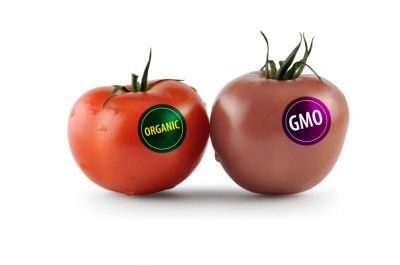Throughout these changes, very little consideration has been given to food labeling, and by and large, consumers have had no idea to what extent the food they buy is contaminated with pesticides or genetically modified. Ironically enough, we now label normal food as "organic" to separate it from pesticide-laden, genetically modified food, which requires no labeling at all.
Call me silly, but shouldn't it be exactly the opposite? Shouldn't organic foods be the norm, and adulterated foods have labeling requirements? For example, how would you feel about a box of cereal labeled as "GMO Corn Flakes" sitting on the shelf at your local grocery store? Would you buy an apple with a sticker that said "Grown using pesticides"? Maybe, but probably not. The fact is, 86% of the corn grown in this country has been genetically modified, so unless that box of cereal is labeled "non-GMO," chance are, it's full of GMOs. And according to the Pesticide Action Network's What's On My Food? Guide, multiple pesticides are found in the majority of conventionally grown apples. But you certainly won't see any of these things on a label.
At the very least, consumers deserve to have the necessary tools to make an informed decision when shopping for food. Thomas Jefferson once said, "An educated citizenry is a vital requisite for our survival as a free people." So why is the government making policies that keep vital, potentially life-saving information out of the hands of its citizens.
Recent polls indicate that the overwhelming majority of Americans think GMO foods should be labeled. By some estimates, over 75% of all processed foods sold in the U.S. contain a GMO ingredient. Most frequently these ingredients are corn, soy, canola, cottonseed, sugar, beef or dairy. And despite what Big Agra would like us to believe, there it absolutely no proof that long-term consumption of GMOs is safe. I am quite certain that in coming years, more and more consumers will also want to know exactly what pesticides are being applied to their food as well.
So why won't the USDA mandate that all food containing GMOs be labeled as such? Well, the short answer is that the U.S. government's current stance (which happens to be identical to Big Agra's stance) on GMO foods is that they do not "differ from other foods in any meaningful or uniform way." I beg to differ! And, if GMOs are truly as harmless as they say, what's the harm in labeling them? The same can be said of pesticides and other chemicals.
Now, I don't really mean to demonize the food industry. Despite the feelings of repulsion I have towards Big Agra companies like Monsanto, I realize that the initial intentions behind the industrial farming practices I so often rail against were, in fact, good. Years ago, the American food system and economy were very different. Hunger and malnutrition were widespread. Then, the agriculture industry learned that they could increase crop yields and make food more affordable for all, simply by applying certain chemicals to crops as part of the growing process, which at the time, seemed like a reasonably safe thing to do. Long-term, not so much. Our problem now, as evidenced by growing rates of obesity, diabetes, heart disease and cancer, is an overabundance of low-quality, high-chemical food.
Would changing the way we label foods containing pesticides or GMOs help to change people's eating habits? The government seems to think labeling works, when it comes to getting people to select "healthier" foods based on their nutrient content, or to avoid things like cigarettes, which have been proven to be harmful. So it stands to reason that clear labels on foods containing potentially harmful substances would effectively deter consumers from purchasing them. Alas, the government seems more interested in protecting Big Agra's profits than in the health of its citizens.
I also appreciate the fact that the USDA has set standards for organic labeling, though the enforcement of these standards clearly needs some work. Organic labeling enables consumers to make purchasing decisions that, at the very least, minimize their exposure to harmful chemicals, and encourages food producers and manufacturers to clean up their acts. Consumer demand for clean, organic food is growing, and so is demand for honest labeling - particularly, of GMO foods, for which there are currently no labeling standards whatsoever.
If buying all of your food organic is not feasible for you, there are many simple choices you can make to minimize your consumption of foods containing chemical toxins and GMOs. We may be a long way off from having the way food is labeled changed altogether, so in the meantime, I encourage you to use the following resources to help guide your food shopping decisions:
- The Organic Consumers Association's Non-GMO Shopping Guide
- The Environmental Working Group's Shopper's Guide to Pesticides in Produce
- The Pesticide Action Network's What's On My Food? guide




Reader Comments
to our Newsletter